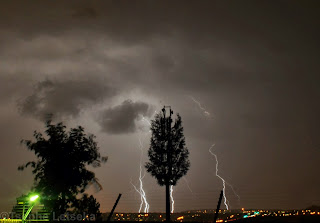Lightning is one of the most powerful and most spectacular forces of nature. It is also one of the most common and therefore one of the most dangerous as well. Strange as it sounds, these are the reasons I have developed such a love for it. Its beauty and power have kept me enthralled since I was a little boy, although at that time it was more fear than fascination. My true fascination with it started when I was high school when I eventually overcame my fear. Since then, I always make sure that I am able to watch every storm that passes by.
 |
| Lightning during a storm in Pretoria on 12 November 2013 |
I've always been fascinated by lightning photography, but in the past it's never really occurred to me to try it because I always thought it is so complicated and that you need fancy expensive equipment to do it. That was until I got my first digital camera. It was a simple Canon 4 megapixel point and shot camera. I had my doubts about it but then I shot my first lightning pic with it in November 2006 and I was hooked.
 |
| My first lightning photo, shot in Rietvalleriand in Pretoria in November 2006. |
Here's the thing about lightning photography. If you have the right equipment, that is a good camera, with a fully charged battery and enough space in you memory card (believe me you'll need the space. You'll shoot lots of pics before you get that money shot), a tripod and a remote trigger, then you're all set to shoot some lightning. Those are the basics that you need for good lightning photography. Any good digital camera though will do, as long as it has settings that allow for long exposure shots. I shot the photo below with an AgfaPhoto Compact 100 point and shoot digital camera on the 14 November 2013. I didn't use a tripod or remote trigger. I rested the camera lens against the window, using the burglar proof bars to keep it steady. Of course as you can see, my hands weren't quite steady enough in this case as you can see that there was quite a bit of camera shake, which is noticeable with the lights in the distance. But the lightning itself came out perfectly. That is why a tripod is very important.
 |
| Lightning during an intense storm in Pretoria on the 14 November 2013 |
People often wonder how it is possible to photograph something that is so fast and unpredictable like lightning. I used to wonder the same thing before I started doing it myself. I always thought lightning photography was a complicated thing that ordinary folk like myself couldn't do. I was quite excited to discover to the contrary that that was not the case.
So the question at hand is how do you photograph lightning?
Lightning photography is not actually not as hard as many people think. Of course that is not to say it is easy either. The point is it is not quite as complicated as many of you think it is. An important thing about lightning photography is that you need plan for it. Yes, I know, how do you plan for something you can't predict? That's the question I'm sure people always ask. Well here's the thing, a thunderstorm is a large system, covering a relatively large area. During it's lifespan, which can be anywhere from 30 minutes to several hours, it will produce anywhere up to several hundred lightning strikes. If you are in the right location, there is always a chance that you can get at least one or two very shots during the course of the storm. The most important attribute that every lightning photographer needs is patience. The reality is you're not going to get the perfect shot immediately when you start taking pictures, although there are very rare exceptions when it does happen. Most likely, you'll go through several dozen bad and dull shots before you get that perfect one. That's just the nature of lightning photography. If you're generally not a patient person, then lightning photography is just not for you.
There are a number of sites that give tips on lightning photography which I could include here, but that would fill up the entire post and I don't want that. So I have attached these two links to the two sites I felt give the best tips on how to get the best lightning shot you can get.
 |
| Lightning strike in Pretoria on the 20 October 2013 |
Lightning is not only a joy to photograph but it is also such a wonder to watch. Watching such a powerful force of nature streaking across the sky and then striking the ground is alluring and mesmerising as it is frightening. Perhaps that is why lightning photographers like myself feel such a sense of accomplishment and gratification at capturing such a powerful force of nature on camera. Getting the perfect shot after going through 20 or 30 and sometime even 50 to 100 dull ones is probably the happiest moment of any lightning photographer. It is certainly always a happy moment for me.
No comments:
Post a Comment